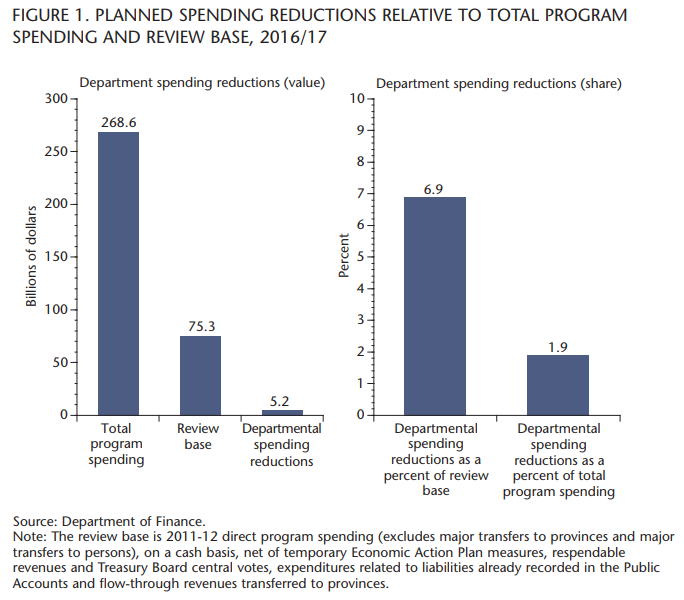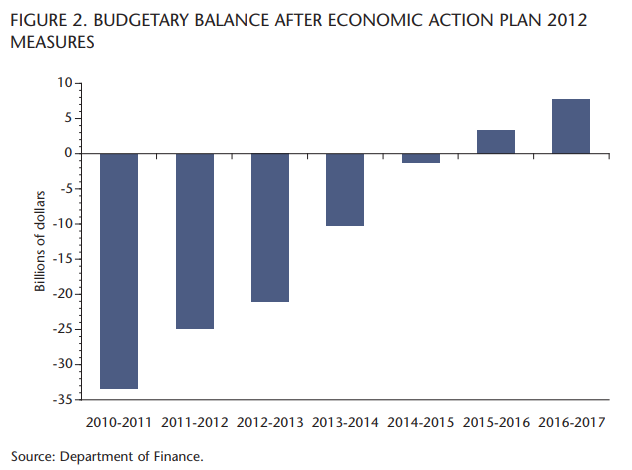
This is a time of worldwide economic uncertainty and fragility. Canada is emerging from a global economic recession, but there is increasing competition from emerging market countries, and Canadian leaders need to make the right choices in order to move our economy forward to another era of prosperity. Countries around the world face a stark challenge: how to create the conditions for growth and prosperity or risk long-term economic decline. It is in that context that Canada’s Economic Action Plan (EAP) 2012 was created. With this plan, found in Budget 2012, the Harper government is seeking to accomplish a number of simultaneous tasks, namely policies designed to set our country on the road to long-term prosperity, while returning to budgetary balance in the medium term.
The budget’s EAP 2012 is a comprehensive economic document. It goes beyond the fiscal ledger of federal spending and revenues, and articulates a vision for future growth and sustainability in the areas of resource development, immigration, business R&D, future trade and red tape reduction.
Nonetheless, returning to a balanced budget is crucial to securing prosperity now and for future generations. Sound fiscal management keeps interest rates low, encouraging businesses to create jobs and invest in the future. Eliminating the deficit also means that money that would otherwise be spent paying interest on a growing debt can be reinvested into the priorities of Canadians, ensuring that the public services they expect from their government are sustainable in the long term. Furthermore, balancing the budget strengthens our country’s ability to respond to future economic shocks such as the recent global financial crisis.
In the period leading up to the crisis, $105 billion of the federal debt was repaid. Consistently balancing the budget in turn gave our country the room we needed to respond when faced with the worst global financial crisis since the Great Depression. Through our Economic Action Plan, $60 billion in much-needed stimulus was injected into the economy, spurring economic growth and creating jobs while keeping our net debt-to-GDP ratio well below our G7 counterparts. To put that in perspective, according to the International Monetary Fund, Canada’s net debt-to-GDP ratio for 2011 was just under 35 percent while the average in the G7 is more than double that, at 80 percent.
Our stimulus plan has worked. While we remain concerned about the number of Canadians who are still out of work, our country has recouped all of the jobs lost during the recession. Some 610,000 more Canadians are working today than when the recession ended, resulting in the strongest rate of employment growth during the recovery by far among G7 countries. About nine in 10 positions created since July 2009 have been full-time positions and close to 80 percent are in high-wage industries.
Real GDP is now significantly above prerecession levels — the best performance in the G7. Both the International Monetary Fund and the Organisation for Economic Co-operation and Development predict our economy will again be among the leaders of the industrialized world over the next two years.
In addition, three credit rating agencies — Moody’s, Fitch and Standard & Poor’s — have reaffirmed their top investment-grade ratings for Canada. Moreover, Forbes magazine recently ranked Canada the world’s best place to do business. By any standard, Canada has weathered the global economic crisis and ongoing financial uncertainty remarkably well, particularly when compared to most other developed nations.
While running temporary deficits was necessary to get our country through the very worst of these difficult times, Canadians have consistently told us that spending designed for a rainy day should not become an all-weather practice. Taxpayers want responsible government spending so they are not passing on an enormous debt burden to their children and grandchildren.
As a condition of our efforts to balance the budget, we identified four courses of action that we were not willing to consider. The first was to raise taxes on businesses and hard-working Canadians. We know from past experience that raising taxes stifles economic growth and job creation. That is why we have cut taxes across the board — income taxes, business taxes and consumption taxes. Actions taken by the government since 2006 will have reduced taxes on individuals, families and businesses by about $220 billion by 2015. That is over $3,000 in tax savings for an average Canadian family per year. In total, the present government has introduced close to 120 tax-relief measures since 2006. While other countries are bringing in large tax increases to address their sizable debt burdens caused by out-of-control spending and repeated deficits, our record of sound fiscal management allows us to reject that option. Here at home, Canadians have seen this debate unfold as the tax-and-spend opposition parties advocate for increased taxes on families and businesses. We remain firmly committed to a low-tax plan that creates jobs and strengthens the financial security of Canadians.
According to the International Monetary Fund, Canada’s net debt-to-GDP ratio for 2011 was just under 35 percent while the average in the G7 is more than double that, at 80 percent.
The second option we did not consider was to reduce transfer payments to other levels of government in support of health care, education, social services, equalization payments and the gas tax transfer to municipalities. We will honour our commitment and continue to invest in a universal health care system and social programs that Canadians depend on to ensure the system is there when they need it. The third option we excluded was to cut major transfers to persons, such as those for seniors, children and the unemployed. That is an approach that some heavily indebted countries in Europe are taking — with massive cuts to public services required to meet obligations to creditors. However, our efforts to pay down debt in good times has meant that we do not have to contemplate the severe austerity measures other countries now face.
Of course, families everywhere have had to take a look at their own expenses and set priorities to live within their means. The Canadian government is doing the same. We are now taking further action to ensure that the government lives within its means by eliminating funding to programs that have achieved their objectives, are no longer needed or are not consistent with the federal government’s roles and responsibilities. Our efforts are about delivering the right programs to Canadians at the right cost, an objective that cannot be accomplished by across-the-board cuts. A thorough examination of all operations is required to achieve savings and improve programs and services.
That is why our government has looked under the hood of every activity, program and service to make sure they are operating efficiently and effectively. We assessed which of these could be delivered at a lower cost or in a more effective way. We assessed whether they are achieving the expected results, whether they are a government priority and whether they are affordable during a period of fiscal restraint. Moreover, we determined whether they are still necessary and relevant. Another crucial test was examining to what extent the programs, activities and services are consistent with the federal government’s roles and responsibilities and whether other levels of government, the private sector or the not-for-profit sector would be better positioned to deliver these. We also put our internal services under the microscope to see if they are delivering results and value for money for taxpayers. This required verifying whether standard business processes could be put in place and whether improvements could be made to streamline and reduce duplication.
But as Finance Minister Jim Flaherty has said before, if you focus on the savings in EAP 2012, you are missing the point. The savings from this review amount to less than 2 percent of federal program spending overall. The focus is really on creating jobs, growth and long-term prosperity. The Economic Action Plan will solidify the entrepreneurial sector’s role as the driving force behind Canada’s economy. Canada’s businesses have proven time and again that they are up to the task when they are given the opportunity.
With that in mind, EAP 2012 invests significantly in training, infrastructure and opportunities, and supports job creation by small businesses. For instance, we are extending the temporary EI Hiring Credit for Small Business for one year to reduce the cost of hiring new workers.
This will benefit approximately 536,000 employers, reducing their 2012 payroll costs by about $205 million. In more targeted labour market actions, we are investing $50 million through the Youth Employment Strategy, to assist more young people in gaining tangible skills and experience and connecting them with jobs in fields that are in high demand. And at the other end of the demographic scale, we are also funding the extension and expansion of the successful Third Quarter project, which helps employers find workers over 50 who have the skills they are seeking.
Action Plan 2012 will also be putting a renewed focus on training of Aboriginal peoples, to ensure they acquire the skills they need to succeed in today’s modern workforce. And for newcomers to our country, our immigration policies will put a greater emphasis on attracting skilled people who can be integrated into our economy quickly where they are most needed.
The Action Plan includes research, development and innovation strategies as well. While Canada leads the G7 in public investments in R&D to universities and granting councils, our business R&D has lagged our trade competitors. By taking seriously the recommendations of the Tom Jenkins panel, committing to overhaul the Scientific Research and Experimental Development (SRED) tax credits and doubling up on Industrial Research Assistance Program (IRAP) grants for business innovation, the Action Plan paves the way for an innovation renaissance in our business sector.
Another key is our government’s commitment to leverage our country’s tremendous natural potential, with new and renewed measures in support of energy and mineral exploration — for example, by extending the Mineral Exploration Tax Credit for an additional year and improving access to modern, reliable seismic data for offshore resource development and funding to assess diamonds in the North.
As minister for FedNor, I am also particularly pleased to see that our plan signals determination to get large projects, such as oil and gas pipelines and the chromite mine in Northwestern Ontario, off the ground. We simply cannot wait 10 years or more as lawyers and opponents of development tie these projects up in knots forever. In the national interest, we have to move forward.
And to leverage all of these measures on a global scale, the Action Plan will expand trade and open new markets for Canadian businesses. Free and open trade has long been a powerful engine for Canada’s economy; we know this and have acted on this understanding. In less than six years, Canada has concluded new free trade agreements with nine countries. We have concluded or brought into force foreign investment promotion and protection agreements with 10 countries and are in active negotiations with 10 others.
Another vital part of the plan that I am involved in as president of the Treasury Board is cutting red tape and reducing the regulatory burden for Canadian businesses.
Government red tape is a job killer, especially for small business. It takes up precious time, impedes productivity and curbs the entrepreneurial spirit, as well as hindering voluntary compliance by undermining the trust between government and citizens. Cutting red tape, therefore, enables businesses to focus on what they do best: sustain the economy by creating jobs and growth. The Red Tape Reduction Commission, struck last winter, paid particular attention to the concerns of small and medium-sized businesses and focused on finding solutions that help businesses invest in productivity rather than comply with unnecessary regulatory requirements. The commission issued its final report last month and as a sign of our government’s commitment, I announced pre-EAP 2012 that we are implementing a “one-for-one” rule to control administrative burdens on business. This means regulators will be required to remove at least one regulation of greater or equal burdens each time they introduce a new one that imposes administrative burdens on business. We are the first government in the world to do this, and my expectation is that this change in itself will require the civil service and politicians to look beyond the usual regulatory policy tools and put business and community growth first.
The budget is merely the start of a root-and-branch transformation that is necessary to ensure Canada can compete and succeed as a 21st century society. Hard work and sacrifice throughout the centuries have got us where we are today; leadership and fiscal prudence will attend to tomorrow. The reforms presented are substantial, responsible and necessary. They will ensure that across the government we are focused on enabling and sustaining Canada’s long-term economic growth. The Economic Action Plan 2012 takes important steps to address the challenges and help take advantage of the opportunities of the global economy, while ensuring sustainable social programs and sound public finances for future generations.
Photo: Shutterstock









